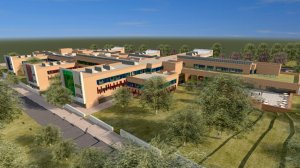A year after first breaking ground on the 238-bed, eight-theatre Nelson Mandela Children’s Hospital (NMCH), in Parktown, Johannesburg, the Nelson Mandela Children’s Hospital Trust (NMCHT) continues to advance the legacy project with a view to admitting its first young patient in the first half of next year.
Located on land gifted by the University of the Witwatersrand (Wits) Education Campus and lying adjacent to the Wits Medical School and the Charlotte Maxeke Johannesburg Academic Hospital, the paediatric facility would, once completed, become the fifth facility of its kind on the continent and only the second in South Africa, alongside the Red Cross Children’s Hospital, in Cape Town.
In line with government’s Modernisation of Tertiary Services plan, the hospital would house several speciality centres, including a haematology and oncology unit, a cardiology and cardiothoracic surgery, a neurosciences unit, a renal unit, a pulmonology unit, a craniofacial unit and a general paediatric surgery unit.
The NMCH would also appoint specialists to treat communicable diseases, such as HIV, tuberculosis and malaria.
Government, through the Department of Health, had committed to supporting the operational costs of the hospital that were related to the care of public patients, while private patients would be funded by medical aid funds and patients from the Southern African Development Community through the provisions of bilateral agreements.
LIVING LEGACY
NMCHT CEO Bongi Mkhabela told journalists that an expansion of healthcare facilities for children in Africa would engender the “living legacy” of former Statesman Nelson Mandela, enabling each child that passed though its doors to experience the spirit of the struggle icon.
“[Through this project], we are creating the kind of world we want our kids to inherit…and 20 years from today, when we look at what we’ve done, we [will see that we have] built a knowledge base for our children and a facility in which they are cared for.
“Africa needs to begin to define and redefine itself [in terms of the way that it treats its children], and this is part of the redefinition of Africa that we want to create. This hospital will be the statue [of Madiba] that will never fall,” she said during a media tour of the site on Wednesday.
Project contractor Group 5 outlined during a progress update that the hospital would be structurally complete by the end of the year before being commissioned in the first few months of next year.
While not a Green Star South Africa-rated project, Group 5 Building MD Tim Nicholls told Engineering News Online that the company had complied with all local regulations regarding energy efficiency when modeling and designing the hospital’s heating, ventilation and air conditioning system.
“Energy efficient lightbulbs have also been included in the design,” he outlined.
Nichols added that some 35 subcontractors and 800 people had been deployed during the construction phase of the facility, which would, once operational, also serve as a paediatric and medical training facility.
“The aim is for the hospital to become it own training ground and we aim to train far more [medical staff] than we require,” commented project adviser Professor Keith Bolton.
This would result in the development of local skills and a knowledge base in Southern Africa, in alignment with the wishes of the project’s namesake, added Mkhabela.
FUNDING-HUNGRY
She told Engineering News Online that the NMCHF had, thus far, raised around R610-million of the R1-billion required to build, equip and decorate the facility, as well as provide training to the requisite number of staff.
Over 60% of these monies had been raised within South Africa, while international donors included humanitarian organisation Islamic Relief, which gifted $11-million and the Bill and Melinda Gates Foundation, which donated $10-million.
South African petroleum group Engen had pledged a further R4-million.
“We have also received a pledge from a US foundation that wishes to remain anonymous that it will match every rand donated by a South African company or group with a dollar, which will allow us to close that funding gap quicker.
“There are also opportunities for naming rights in the hospital by corporates, so you can essentially buy a piece of the hospital,” said Mkhabela.
NMCHF trustee and project lead Joe Seolane told journalists that he hoped that the development of the NMCH would serve as a catalyst for the development of paediatric facilities elsewhere in the region.
“We hope that the hospital will start activating the development of similar hospitals. It’s a pathfinder in this sense,” he asserted.
He added that there was an option to expand the hospital to an up to 300-bed facility within five years of opening, if required.
EMAIL THIS ARTICLE SAVE THIS ARTICLE
To subscribe email subscriptions@creamermedia.co.za or click here
To advertise email advertising@creamermedia.co.za or click here










